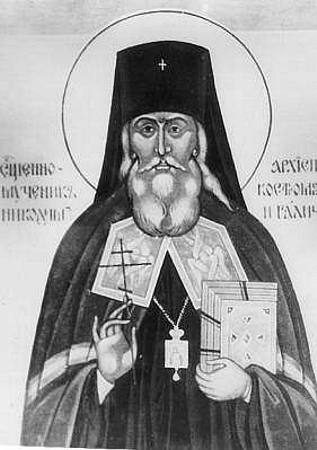Saint TRIANTAPHYLLOS, natif de Zagora près de Volos, marin de profession, martyr à Constantinople par la main des Musulmans (1680).
Saint ANASTASE, Bulgare de nation, armurier de profession, martyr à Thessalonique par la main des Musulmans (1794).
Saint EUTHYME, abbé du monastère Saint-Jean-Baptiste de Garédja, martyr (Géorgie 1804).
http://oca.org/saints/lives/2015/08/08/103871-st-euthymius-the-elder-of-the-st-john-the-baptist-monastery
Saint PHILARETE d'Ichalka (Russie 1913).
Saint JOSEPH, moine, martyr par la main des Communistes (Russie 1918).
Saint NICOLAS, prêtre, martyr par la main des Communistes (Russie 1937).

Saint NICODEME, archevêque de Kostroma, martyr par la main des Communistes (Russie 1938).
Deuxième translation des reliques des saints Zosime, Sabbatios et Germain de Solovki (Russie 1992).
St. Maxim Sandovich
St. Maxim was born in the village of Zhdynia, Galicia. It was under the Austro-Hungarian Empire, but it had been part of the Ukraine. The Austro-Hungarians did all they could to root out any sympathy for Russia. They further latinized the uniate liturgy and they viewed all Orthodox as Russian conspirators. Maxim's parents, Timko & Christina, were devout people. They saw to it that Maxim received a good education, but they could not afford much. His father arranged for him to stay in the Russian Dormitory provided for poor students at the high school in Nowy Sacz. There Maxim learned Russian history and the history of the Church. But he realized that this school was still too expensive for his family, so after his first year, he transfered to the uniate school run by Basilian monks. He found their teachings and their way of life repugnant. He left after a few weeks. He found his way across the border to Russia and entered the Lavra at Pochaev. From there, Archbishop Anthony Khrapovitsky sent him to the Orthodox seminary at Zhitomir in 1905. He graduated in 1910. When he visited his home for Pascha and Bright Week, the people of the area were excited to have an Orthodox seminary graduate in their midst. Some who had grown up in the unia, had traveled to America and had made their confessions to Orthodox priests there. They urged Maxim to seek ordination and return to Hrab and start an Orthodox Church. He promised them he would. The following year he was married and ordained. When he and his wife arrived in town, his appearance caused an uproar. The uniate clergy mocked him for his beard, long hair and riassa, saying, "Look! St. Nicholas has come to the Carpathians!" The church grew and flourished to the point that crowds stood around the windows outside to catch a glimpse and to join in the services. He was repeatedly arrested and harrassed on false charges. The uniate clergy had him and several parishioners arrested for burning candles in church. He was arrested in 1912 for capital espionage along with a priest in a neighboring town when he went there to make his confession. They were held for two years. They were finally brought to trial and found innocent. He was released on June 6, 1914, and he returned to Hrab. He was only able to minister a short time, when he was arrested again; this time, with his pregnant wife and his father, on August 4, (three days after Austria-Hungary had declared war on Russia).They were all kept in one cell until 5am on the 6th when Timko and Mrs. Sandovich were moved to a cell with a window facing the street. They then took Maxim out, blindfolded. Placed him with his back against the wall. He knew this was the end and he said: "Lord bless." Just before the order to shoot was given, he shouted: "Long live Orthodox Rus!" Two men shot him from six paces away. His body did not fall over as it was leaning against the wall so one of the soldiers went over to him and shot him three times in the head with his revolver. St. Maxim's son, Maxim, later returned and pastored a thriving Orthodox community there.


Nessun commento:
Posta un commento
Nota. Solo i membri di questo blog possono postare un commento.